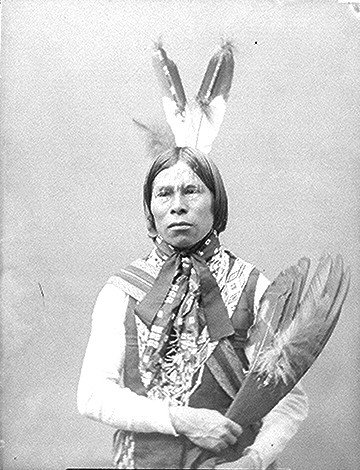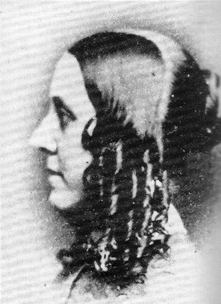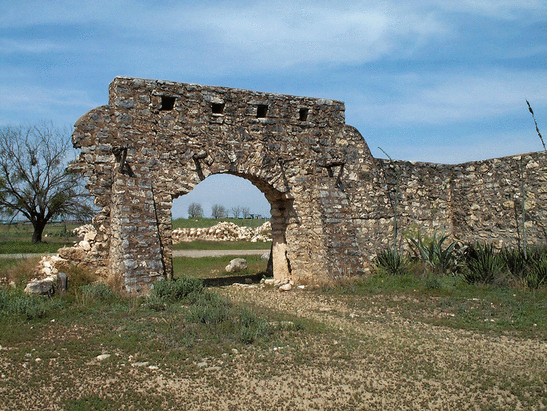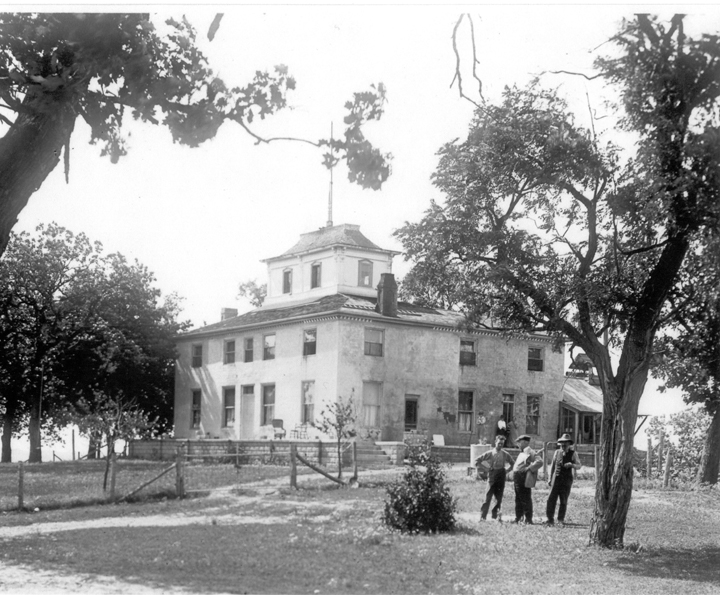A Life in Transition
1851-1860
Horace Capron ended an important phase in his life when his Laurel ventures failed. Many adventures and significant accomplishments lay ahead of him -- but none of these would have seemed obvious at the time his finances collapsed. He needed work, and an opportunity to make a new beginning. He wrote to members of Congress, including Daniel Webster, looking for a position. He was able to find a commission in Texas. When it finished, he moved to Illinois.
Sensitive to the great change in my position; and longing for relief …I obtained a commission as special Agent of certain tribes of Indians in Texas, and along the Rio Grand borders” Horace Capron Autobiography p 79.
Sensitive to the great change in my position; and longing for relief …I obtained a commission as special Agent of certain tribes of Indians in Texas, and along the Rio Grand borders” Horace Capron Autobiography p 79.
 A Member of the Kickapoo Tribe
A Member of the Kickapoo Tribe
Texas
The Texas that Capron experienced in 1853-4 was still a frontier, and had only been a state six years. He visited San Antonio, where the famous battle of the Alamo was still part of recent memory. Horace Capron does not seem to have been completely enamored of Texas -- and found some of the native fauna a challenge.
“Once whilst reconnoitering around the ruins of an old Mission on the San Saba, an immense snake crawled out from under a pile of rubbish upon which I was standing…My trusty six shooter was soon out [and] I …put a ball through two lengths of his coil. …he measured 9 feet in length." Horace Capron Autobiography p. 95
Capron’s Texas charge was to move Native American tribes, including Delawares, Shawnees, Creeks, Comanches, Kickapoos, Wichitaws and others to new territories. His attitudes reflect conventional thought of his time. He does not seem to have questioned either the mission or the morality of his work. He was, however, deeply troubled by how the Indians were treated.
My own sympathies were entirely with the Indians….Simple justice to the Indian in all our transactions, would...not only have saved all the suffering and bloodshed of the past, but reconciled them to the gradual change, which our civilization required to fit them for the position of useful citizenship. HC Autobiography p. 94
I would most respectfully recommend to the Government of the United States that before a war of extermination is waged upon these poor misguided, but brave bands, that the truth of what I have written may be inquired into….” Horace Capron report to the Hon. Geo. W. Manypenny, Commissioner of Indian Affairs, 1853, as reported in HC Autobiography p. 127
The Texas that Capron experienced in 1853-4 was still a frontier, and had only been a state six years. He visited San Antonio, where the famous battle of the Alamo was still part of recent memory. Horace Capron does not seem to have been completely enamored of Texas -- and found some of the native fauna a challenge.
“Once whilst reconnoitering around the ruins of an old Mission on the San Saba, an immense snake crawled out from under a pile of rubbish upon which I was standing…My trusty six shooter was soon out [and] I …put a ball through two lengths of his coil. …he measured 9 feet in length." Horace Capron Autobiography p. 95
Capron’s Texas charge was to move Native American tribes, including Delawares, Shawnees, Creeks, Comanches, Kickapoos, Wichitaws and others to new territories. His attitudes reflect conventional thought of his time. He does not seem to have questioned either the mission or the morality of his work. He was, however, deeply troubled by how the Indians were treated.
My own sympathies were entirely with the Indians….Simple justice to the Indian in all our transactions, would...not only have saved all the suffering and bloodshed of the past, but reconciled them to the gradual change, which our civilization required to fit them for the position of useful citizenship. HC Autobiography p. 94
I would most respectfully recommend to the Government of the United States that before a war of extermination is waged upon these poor misguided, but brave bands, that the truth of what I have written may be inquired into….” Horace Capron report to the Hon. Geo. W. Manypenny, Commissioner of Indian Affairs, 1853, as reported in HC Autobiography p. 127

Illinois: A New Start
Horace Capron's Texas adventure ended with a new administration (his was a political appointment). In January 1854 he married Margaret Baker of New York. We know very little about Margaret, other than that her father's name was William. We do not know how and when Horace met her.
Horace's mother Eunice had moved to Illinois and owned a farm. This was the farm to which Horace and his new wife and his children moved, and which he purchased. Sadly, his daughter Adeline had died in 1852. Their new home was known as The Mansion.
In Illinois Horace again began farming.. His took up his previous focus was on his favorite North Devon breed, and he again won prizes. Agriculture had clearly superseded factories as his primary interest and passion. He eventually moved to a second farm in Peoria.
Horace Capron's Texas adventure ended with a new administration (his was a political appointment). In January 1854 he married Margaret Baker of New York. We know very little about Margaret, other than that her father's name was William. We do not know how and when Horace met her.
Horace's mother Eunice had moved to Illinois and owned a farm. This was the farm to which Horace and his new wife and his children moved, and which he purchased. Sadly, his daughter Adeline had died in 1852. Their new home was known as The Mansion.
In Illinois Horace again began farming.. His took up his previous focus was on his favorite North Devon breed, and he again won prizes. Agriculture had clearly superseded factories as his primary interest and passion. He eventually moved to a second farm in Peoria.



